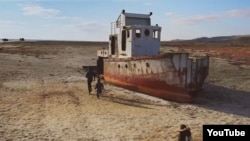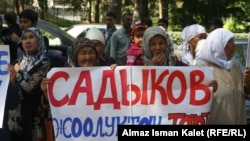
The legendary rock group Pink Floyd has a new album, "The Endless River," and it has a Central Asian connection. The video for the song "Louder Than Words" was filmed on the northern part of what once was the Aral Sea.
RFE/RL's Uzbek Service, known locally as Ozodlik, contacted Aubrey Powell, the creative director for Pink Floyd and someone who has been working with the band since 1967. He explained the choice of the site, the difficulties in obtaining permission to film there, and the message behind the video.
For inspiration, Powell said he looked back to a video he had done earlier this year for the song "Marooned" from the 1994 album "The Division Bell."
"I decided for that [video] to go to Chernobyl -- [the town of] Pripyat. And we shot that film there, and it had fantastic reception because it was drawing people's attention to the death of that city through nuclear power and the dangers of nuclear power," he told Ozodlik.
Powell said that brought him to think about doing the new video "about an environmental situation -- and one of the first things that sprang to mind was the Aral Sea."
The Aral Sea, once the fourth-largest inland body of water in the world, is dying. The diversion of water during Soviet times from Central Asia's two great rivers -- the Syr-Darya and Amu-Darya -- into the cotton fields of the region have shrunk the lake to some 10 percent of its original size in less than 100 years. The exposed soil became alkaline and the wind in the area now blows salt through the region, causing health problems and withering crops.
Fishing boats that once plied the Aral Sea are now rusting hulls lying in the desert many kilometers from where the shores of the lake are now.
It was that surreal quality of ships stranded in the emptiness of the desert that appealed to Powell; but as he said, he also wanted to bring an environmental message to people. Powell said the video is "not so much about the disaster -- that's been written about endlessly -- but more about a generational thing, more about what it means to the younger generation, the children of the impoverished and disenfranchised communities around the Aral Sea that have lost fishing and culture."
Children dominate the end of the video as they play in these rotting vessels lying in a desolate landscape. Powell said, "that's in part what the film is about and it's about the fact of their loss and their only knowledge of the sea, and the beauty of that sea, and what it represented to their community, is through their grandparents or their parents, but they [the children] will never know."
The video for "Louder Than Words" was filmed in around Aralsk, Kazakhstan, one of many once-thriving fishing villages ringing the Aral Sea in what is today Kazakhstan and Uzbekistan.
And that brings up the choice of Kazakhstan. It was not Powell's original choice -- that was Uzbekistan, or preferably both countries. But as Powell explained, "In Uzbekistan, to go and film in Uzbekistan, you have to be invited by a company." Powell said he had contacts in Uzbekistan but they didn't have licenses; and the Uzbek Embassy in London told him even once the proper invitation from a licensed company was extended, it would still be two or three weeks to process.
"So I said, 'OK, I can't go to Uzbekistan, I'll go to Kazakhstan,'" and Powell added, "In Kazakhstan, I was in within a week, and we did the film."
Powell said the choice of the title "Louder Than Words" was connected to the saying "actions speak louder than words" and he hoped Pink Floyd's video would draw the attention of the band's followers to what is happening to the Aral Sea and to places where similar processes are just starting. "Their [Pink Floyd's] blog has 28 million followers, so you've got to look at [the video] in the sense of making people aware about what's happening in the world."
I was struck by one comment Powell made during the interview. He noted that in Kazakhstan, at least, many of the ships aground in the desert were being cut up and hauled away for scrap metal, which he said was a shame for the people living there now, and for those who might continue to live there. "Now they've taken away the rusting ships, most of them, their heritage of seeing those monuments to that culture, which has been there for centuries, has been destroyed."
-- Bruce Pannier, based on an interview by Khurmat Babajanov of Ozodlik






